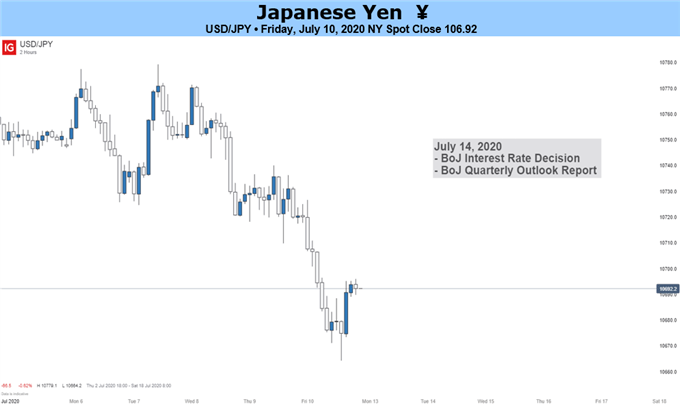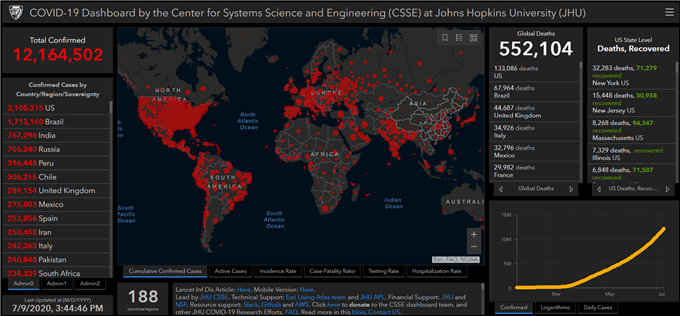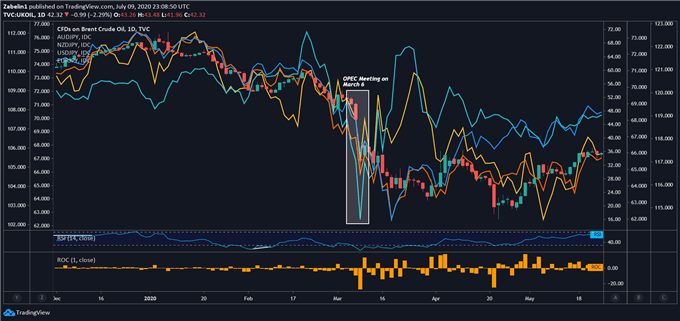
OUTLOOK: BULLISH
- Japanese Yen may get tailwind from risk aversion over concern of surging Covid-19 cases
- Gains may be magnified if US earnings from large market-cap corporations underwhelms
- JPY could also rise if key OPEC+ meeting reveals signs of internal political fragmentation
Coronavirus Cases
The Japanese Yen may rise if a growing number of coronavirus cases – particularly in the US, the largest economy in the world – spurs demand for anti-risk assets. Efforts to mitigate the spread could mean the reimplementation or extension of growth-hampering lockdown measures that have caused global economic activity to slowdown.
Chart Showing Global Confirmed Coronavirus Cases

Source: Johns Hopkins CSSE
The US alone constitutes just under 20 percent of total global cases confirmed, with hot spots like Texas and Florida reporting alarming metrics. Medical statistics in those areas have unnerved already-unsettled investors who are already contending with geopolitical risks in the US – with the upcoming 2020 US presidential election – and rising tension in Hong Kong.
Corporate Earnings
The Japanese Yen may extends gains if earnings from corporate gains like Goldman Sachs, Wells Fargo, Blackrock and a slew of other high market-cap companies miss their earnings estimates. Since the selloff in global equities in March, stock markets have bounced back with renewed vitality, leading to questionable asset prices that may not be justified by poor earnings.
Technology-oriented stocks in particular have shown to be the most resilient category. Since March 16, Apple, Amazon and Alphabet Inc having risen over 60.0, 93.0 and 40.0 percent, respectively. Their disproportionate weight in major US equity indices masks the health of smaller-cap companies that continue to struggle in the worst economic downturn since the Great Depression.
Japanese Yen, S&P 500 Index – Daily Chart

Source: Bloomberg
Consequently, an avalanche of underwhelming earnings reports could shatter the illusion of financial stability and cause a pullback in major equity indices. In this scenario, the anti-risk Japanese Yen may appreciate against a basket of its G10 peers, especially those chained to commodity-linked economies. These include the Australian, New Zealand and Canadian Dollars in addition to the Swedish Krona and Norwegian Krone.
OPEC Meeting: Will Friction Push JPY Higher?
On July 14, OPEC+’s Join Ministerial Monitoring Committee will be holding a conference call to assess each participant’s compliance with production quotas. Internal friction within the alliance has been a source of geopolitical angst among commodity traders. The OPEC meeting on March 6 – where Russia and Saudi Arabia failed to reach a consensus on production – saw crude oil prices plunge; but other assets were not immune.
Chart Showing Crude Oil Prices, AUD/JPY, NZD/JPY, USD/JPY, EUR/JPY – Daily Chart

Crude oil chart created using TradingView
Risk aversion from the geopolitical friction there permeated across bond, currency, commodity and equity markets and caused the Japanese Yen to spike against a basket of its peers. Part of the internal breakdown within the cartel comes from each member pursuing their own interests. Parag Khanna, author of The Future is Asian, wrote in his book in regards to OPEC that:
“…Saudi Arabia’s Saudi Aramco and the UAE’s Abu Dhabi National Oil Company (ADNC) are competing ferociously with Iran, Iraq and Nigeria, and others to be Asia’s top oil and gas supplier. As a result, the OPEC unity of the 1970’s and ’80s has given way to a collapse of coordination, with oil producers jockeying to secure long-term Asia customers”.
The following day, OPEC+ officials will meet and discuss whether or not to extend record production cuts – currently standing at 9.6 million bpd – into August. The other possibility could be maintaining the original target for the next month at 7.7 million bpd. In any case, a lack of coordination or internal fragmentation could roil oil markets and put a premium on anti-risk assets like the Japanese Yen.
--- Written by Dimitri Zabelin, Currency Analyst for DailyFX.com
To contact Dimitri, use the comments section below or @ZabelinDimitri on Twitter




